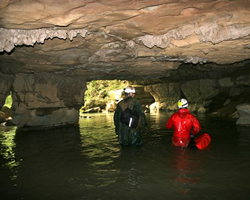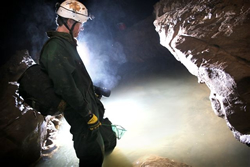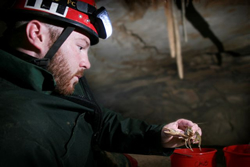Scientists Focus on Blind Crayfish in Search for Cave Ecology Answers
By Chris Bryant

Born eyeless, these small, white, almost transparent animals spend their lives underground and have diets that, seemingly, are mud-centered. Their very existence appears tenuous.
Ok, so you might not score cave crayfish high on a human-based quality-of-life meter, but you’re not apt to beat them in a quantity of days’ contest, either. In fact, some have contended a species of cave crayfish is among the Earth’s longest living organisms, with a possible life span of well over 150 years.
One species of cave crayfish, Orconectes a. australis – a relative of the above ground crustaceans sometimes called crawdads or mudbugs – is the focus of a project University of Alabama researchers hope to expand into a broad-based look into the relationships between caves and the organisms that live within them.
A state wildlife grant is providing UA researchers funding to search for these long-antennaed creatures within 10 Alabama caves. The project involves the capturing, measuring, tagging, releasing and, subsequent re-capturing of hundreds of cave crayfish over a 3-year period. It is designed to reveal more about the crayfish’s population size, individual growth rates and longevity. The search is not an easy one.
“Crayfish can go a lot of places we can’t,” says Dr. Alex Huryn, a UA freshwater ecologist leading the project. And their homes are places few biologists have explored.
“It’s the final frontier,” says Dr. Bernard Kuhajda of caves. “It’s the great unknown.”

In some ways, caves are the near perfect settings in which to study organisms, says Michael Venarsky, a doctoral student in the University’s biological sciences department. “They are these nice, little, perfectly replicated laboratory systems all over the world that have similar environmental characteristics. That opens the door for unbelievable comparison studies.”
In other ways, they’re not so ideal.
“Working in surface streams is difficult enough,” Venarsky says, “but working in cave streams is exacerbated by space. There are a lot of caves you have to swim through, that you have to pull your equipment through.” Many cave species are imperiled, so non-lethal means must be developed for sampling efforts. Some cave passages are so cramped explorers must crawl along the caves’ floors, while others require rappelling into 60-foot sink holes. “It’s facing these challenges and difficulties that most people have avoided,” says the College of Arts and Sciences’ doctoral student.
And there’s that small matter of looking for a 2-4 inch creature in the complete absence of all natural light.
On a recent sampling effort in Hering Cave, southeast of Huntsville, the three UA researchers – insulated with wet suits, boots, and gloves, blanketed by coveralls and topped with helmet lights – gave two visitors a glimpse into their field work.

Entering the cave’s mouth while wading through shin-deep, slowly moving waters, the researchers plod down the boulder-littered stream. With helmet lights illuminating the darkness, they plunge deeper into the cave which lies beneath a mountain. The stream’s mud-covered floor becomes smooth, and the researchers begin scanning the waters for the near invisible. “Ahhh,” groans Venarsky as, equipment in hand, he thrashes at a cave fish. It’s gone as quickly as it appeared. “You’d think a blind fish would be easier to catch,” he quips, poking fun at his miss.
As the waters rise, nearly 6-feet deep in stretches before receding to knee deep levels again, so too do the researchers’ successes. Using small nets for scooping and orange plastic buckets for temporary storage, some 22 cave crayfish are located on this day, including 12 of the primary target species and 10 of a significantly larger species with eyes and more closely resembling small lobsters, in color and body types.
Sitting on a sandy bank beside the stream deep within the cave’s heart, Venarsky later uses calipers to individually measure the dozens of temporarily captured animals.

He carefully inserts tiny identification tags, which are luminescent, on the crayfish’s bellies, just underneath their clear skins.”
Venarsky calls out tag numbers and dimensions which Huryn records in a field journal, while Kuhajda continues the search. For crayfish later recaptured, the tags enable the researchers to determine how much an individual has grown over a set time, before it’s again released.
Later, in Huryn’s office, he and Venarsky discuss the project.
“What we’re starting to realize,” Venarsky says, “is that these populations appear to be much bigger than initially anticipated.”
Seven of Alabama’s 89 known species of crayfish are cave dwellers. “This is a real hotspot for crayfish diversity, worldwide,” Venarsky said. “These cave crayfish are an important, unique part of that diversity.” Six of the cave species are considered imperiled, and the seventh is believed to be extinct.
“From a conservation point of view,” Kuhajda said, “we always talk a lot about the rain forests – half a world away – and how many species are going extinct. And, we have the same thing happening right here in Alabama.”

Caves have much less variation than most environments, so animals that inhabit them are particularly susceptible to change, says Kuhajda, who recently discovered a previously unknown species of cave shrimp. Cave temperatures, for example, fluctuate little regardless of the season. “As we continue to grow as a population, all creatures are going to have a more difficult time finding an acceptable place to live,” says Kuhajda. “We’ve got a lot of diversity here, but we’ve got a lot to lose. I realize that growth has to occur, but we can do it in an intelligent way.”
While a frequently referenced, but never formally published, study from the 1970s indicates some cave crayfish were living more than 150 years in its dark habitats, Huryn says he’s skeptical of those conclusions. “When I found that out I was pretty amazed,” he says. “One of the things I wanted to do was to get in there and use my own modeling methods to see if I could verify that.”
Kuhajda offers an easy-to-understand fictitious example to illustrate how growth rates can provide insight into longevity. “If they are 8-inches long, and they grow two inches in three years, they are not a hundred-year-old crayfish. If they get to six inches long, and they grow a sixteenth of an inch in two or three years, they are very old crayfish.”

The scientists must also account for the molting of skin the crayfish regularly undergoes and for the possibility that crayfish growth rates are not necessarily constant throughout their lives.
Venarsky says he is also intrigued by crayfish diets, which, based on stomach contents, are known to contain sediment. “We don’t know what they are eating and, more importantly, we don’t know the proportion of their diets. So, how much is coming from sediments, and how much is coming from other animal matter? That’s one of the questions I hope to explore for my dissertation.” It’s an exploration that’s taking the UA scientists deep underneath Alabama’s soils. Eventually, it will take them beyond these fascinating animals.
“We are using this as a portal to burst into bigger questions about cave ecology,” Huryn says. “We’re focusing on crayfish. We think it’s an important element in the food webs, but we’re interested in taking this beyond the crayfish. We want to look at the whole cave food webs and look at energy sources in the different groups of caves.”
Further Reading